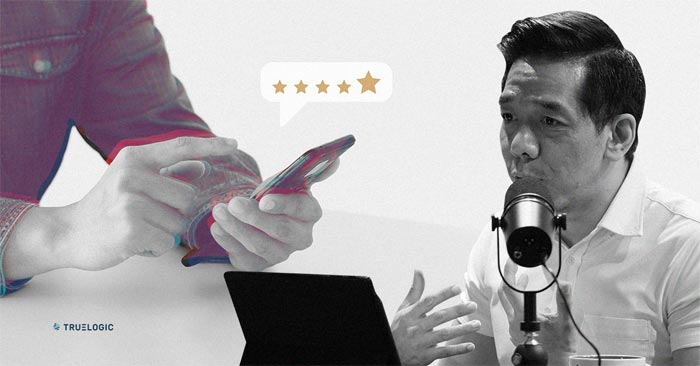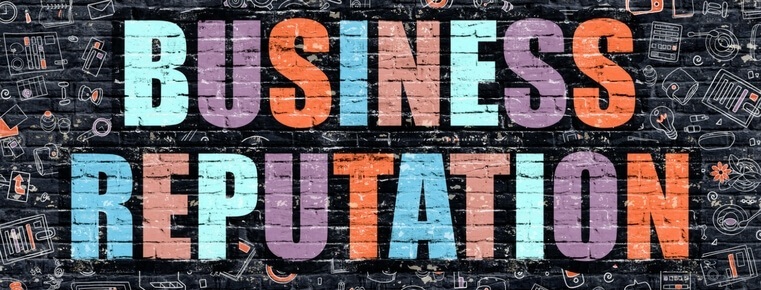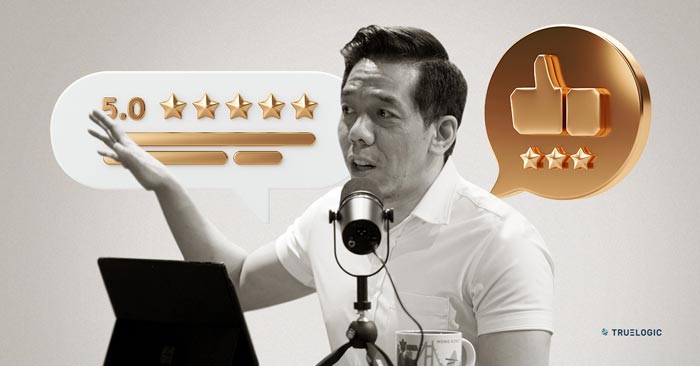Truelogic DX Podcast Episode 10: Building Your Brand’s Online Reputation Part II

How can you ensure a positive reputation online?
Every time a negative review pops up on Google searches, you have the potential to lose customers. At least 86% of customers hesitate to purchase from companies with negative reviews.
Last time we talked about what ORM is and how you can check your current online reputation. Today we’ll continue the discussion and talk about ORM strategies and how you can ensure that what’s being said about you online builds you up and not tear you down.
Podcast Transcription
Hi, and welcome back to another episode of Truelogic DX podcast. In our previous episode, I talked about Proactive ORM or Proactive Online Reputation Management. And today we’re going to talk about something that I jokingly call Online Disaster Risk Reduction Management.
It’s always just called ORM. Some people call it negative ORM, but what do you do when there’s negative sentimentality about your business, your brand online?
Steps in Building a Good Reputation Management
1. Research
In order for you to build a good reputation management program, the first thing that you need to do is research. Execute a search, do it from different IPS. Use proxies if you have to. But if you were dealing with a client or let’s say your own brand, make sure that you do brand searches.
One of the mistakes that I see different brands do is they’ll do [insert brand here] scam, [insert brand here] negative review. So first things first, don’t feed the Google search or suggest any negative ideas about your brand. That’s sort of where it begins first. Don’t begin your negative reputation at all. But do put in a neutral search about your brand and then take a look at the search results. You can pretty much tell from the meta title and the meta description what the search result looks like.
2. Identify the negative content and its position
Now, one of the things that I do when I’m doing research is I don’t give negative results click through. One of the little secrets that I do is I will have my Chrome and I do my Google search on it. And then I have my Firefox and I do my Bing searches on it. And when I find URLs with a negative review about a prospect, a client, or something that I have to work on, I do the search on Bing so I can review the content from Bing, because I mostly worry about their reputation inside Google.
Like Bing, it has 20% of search share in the Philippines, even less. So it doesn’t really hurt their reputation so much if you give that negative results some click through. Plus I didn’t do a brand search, I did a URL search. But I review the content of the pages. If I can’t tell whether the content is positive, negative, or neutral, in terms of sentimentality right from the search, I search for the URL on Bing, or I search for the content on Bing, and then I give it a click through. I don’t give it a click-through from Google.
So the first step is to identify how many of the search results are on the first page, sometimes going all the way to the second page, and you’ll understand why when I get to the later portion of this conversation.
But the reason I think we’ll look at the content is we want to know where I’m starting from, and how hard or easy I’m going to have to work on a negative reputation. We’ll sort of depend on: (a) how authoritative the negative content publication is. Where does this negative sentimentality sit? Does it sit on a website that is highly reviewed? Does that get fresh updates? That has a high authority score on Google.
So my first concern is how authoritative is the site posting the negative content? My second concern is how high it is on the search result. So think about reputation management as if you’re pushing something down. If you’re pushing something from position six, you have to push it four positions down and it’s on page two. But if something were number two, you have to push it nine positions down. And so the amount of work that you have to do when the negative sentimentality about you is above the fold on a Google search is going to be tremendously more.
3. Check your assets
What assets do you have that can help you control the results of the first stage? And this goes back to the previous conversation we had about proactive reputation management. Because think about it, if you were managing your brand’s reputation, and you’ve got your website, you’ve got your PlayStore, you’ve got your YouTube channel, your Twitter page, your LinkedIn profile, your Facebook page. You’ve got your author pages. You’ve got an Instagram page. Well, just those items that I mentioned alone are already eight assets. That’s immediately eight assets that you can use the rank on the first page.
If you hadn’t done any of that legwork, you are in trouble. Because now you have to do the legwork while there’s something negative that sits about you on the first page. Do a neutral Google search and find out how many of those you can positively control, or how many of them you can possibly control for more positive sentiments about you.
4. Put your assets in order
Once you’ve identified your assets, put them in order of: (a) on-page ability, (b) authority. On-page ability means how many of them can you optimize? Like how many of them can you log into and do optimizations, for example, a website. I have dealt with some business owners where this became a problem for them.
And then I realized they’re not running on one business. They’re running five businesses. Then why don’t they have leadership profiles in any of their business websites? All of those are easily owned assets. So the next thing I look to combat the negative reviews or the negative comments or the negative content about somebody is I take a look at what assets I could work with.
And I order them in terms of on-page ability. How many of them can I log into unoptimized? By the way, YouTube channels, Facebook pages and leased assets are unbingeable. There are easy ways to create an optimized YouTube channel versus just a standard channel. There are easier ways to create an optimized Google my business profile. There are easier ways to create an optimized Facebook page versus just leaving it alone to stand.
So I look for optimized assets and then I look for authoritative assets. Now, what do you mean when you say authoritative assets? And this is where you got to put on your SEO hat, you have to plug your potential substitute websites. The ones that you’ll use to push down the negative results into a tool like SEMrush or Moz or Ahrefs, but you will have to use, or even link research tools, you will have to use an authority metric. Because on-page ability and authority are what will tell you whether or not you make headway quickly or whether it’ll take you a long time.
Now you order them based on on-page ability on authority, meaning work on the sites that have high authority first because you can probably squeeze them into the first page in 30 to 40 days reputation management and search as long.
That’s not going to happen. Organic is momentum-driven, even in terms of reputation. So you look for on-page ability, you look for authority.
5. Make noise online
The last thing you need to do is make noise. It’s time for you to start making noise online. So have your positive assets linked back to each other. For those of you that are technical and are, and listened to this conversation, these are the same as codes inside your website.
When you do schema and then you do the same as, and then a Twitter page and a Facebook page and whatnot, you’re declaring to Google that these are my assets. On the flip side, when you build an asset, make sure that you link it back to your website so that Google is clear that there is a direct relationship between this YouTube channel and this website or this brand.
Between this Facebook page and this brand, this LinkedIn profile and this brand, and so on and so forth. So make sure you get them pulling to each other. So make noise with your leased assets.
6. Get contribution from your clients
This last step is the most time-consuming. And also if you outsource it, it is also the more expensive bit to guest post content for your clients.
If they’re in real estate, get them to contribute to real estate websites. If they are in banking, get them to contribute to financial websites. If they are in lifestyle, get them to contribute to lifestyle websites. If they are in nutrition, get them to contribute to medical or nutrition websites.
But this is where a lot of legwork happens because it can literally take you anywhere between four to 12 hours to contribute content to a third-party website so that you can link back to one of the assets that you’re trying to promote. So I know that a lot of this is sort of like in a nutshell, and it’s a bit hard to imagine.
I highly recommend proactive online reputation management. I have never done any negative reputation management that did not bring the 2.5M [peso] marker. It is an expensive activity, especially if there’s something negative about your floating out there already. I’ve always managed to successfully bring down negative results. Or actually, I wouldn’t say bring it down. Pushed it down.
Online Reputation Management Strategies
1. Perform an audit
Whether or not you’re dealing with a crisis, make sure that you’re always performing an audit of the sentimentality about your brand or the search results about your brand.
2. Establish an ORM strategy
Try to have an ORM strategy ready. Whether it’s proactive reputation management or whether it is online disaster management, is up to you. But at least have a strategy to monitor how your brand is mentioned online. Like effectively, there are third-party tools that aggregate reviews.
3. Try to control the first page of Google search.
You will not be able to all the time, but try to dominate as much of it with your, I would say, with the assets that you control. Try to dominate it with your own data assets, your own earned assets, your social assets, and your owned assets.
4. Choose your influencers wisely
Make sure that they resonate with your audience.
5. Have a crisis management strategy
Like with any business, continue with the strategy. You have a crisis management strategy in place, because I think prevention is always better than the cure and significantly cheaper than a cure.
Examples of Online Reputation Management
1. Suntukan sa Ace Hardware
Though sometimes the point of no return is when something goes viral. So I’ll just throw, you know, examples here. I’ll give you a great example of a positive reputation opportunity that I think got missed. For those of you that will be old enough, and I’m not sure if there will be a lot of you guys, do any of you remember the “suntukan sa ACE Hardware” thing?
So there’s this provincial ACE hardware and there was this social media thing where some of their customers were inviting them through. They were inviting like I would say like a fight club in the parking lot. And in the weeks leading up the way, there was a lot of excitement about it, especially on Facebook.
And ACE kept going, “We have nothing to do with this.” “No, there will be no fights.” “No, there is nothing.” And they didn’t ride it because if you listen to the tone on social media, it was clear that everybody was just there for the kicks.
Nobody took it seriously that there would be a fight, but it was a clear missed opportunity for positive reviews about their brand. So that’s an example of a missed reputation management opportunity.
2. Cats of BGC
I will talk about some negative virality though. I’m not sure if you guys remember the curious case of the cats of BGC.
There are some things that proactive rep management can do, for example, even in something as bad as the cats of BGC issue, I’m not sure if you guys remember it. I’m not going to name names in terms of which brand was affected, but essentially the cats in BGC went missing.
This establishment got blamed for having them controlled or having controlled the population, not knowing that the community took care of the cats. But because no reputation management was in place, it dominated position 2, 3, 4, 7, 9 of the brand, essentially half the search results of the first page.
In a situation that’s as viral as that, not even proactive rep management can prevent any negativity, but it can control the volume of negativity. Because clearly if you Googled Cat sa BGC, you’d see the negative result. But if you Googled the brand search, if you’d done your proactive rep management, you might’ve seen one, you might’ve seen two, but you wouldn’t have seen five.
So there will always be a benefit to it. To wrap this, there are two episodes to reputation management. You guys can choose to be proactive about your reputation management and proactive rep management is about managing your bait assets, your earned assets, your social assets, and your owned assets.
Not waiting for a disaster, a virtual disaster, an online disaster. If they hit your brand sentimentality, make sure that you encourage the feedback mechanism from your audiences and your customers and make sure that you respond to any negativity that happens about you online.
And the second phase is what do you do? When it is at online disaster levels, which is what we thought about in this episode. Thank you very much for indulging me for the past 15 to 18 minutes. Again, this has been Bernard and thank you for joining us on this episode of the TrueLogic DX podcast. I hope you guys learned something useful and something actionable.
Hopefully, you’re not in a position where you are in a dire reputation management situation. But regardless one way or the other, I hope that it helps.
Leave a comment on YouTube. follow us on LinkedIn. And as always, we’re available with Podmachine. Thank you very much for the collaboration. I’ll see you in the next episode. Cheers.






